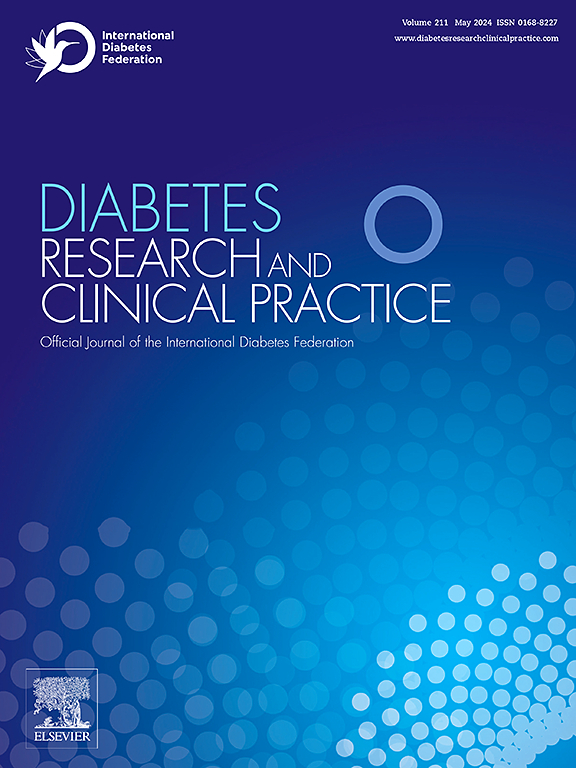Association between body roundness index and chronic kidney disease risk in patients with diabetes: A cross-sectional analysis of NHANES 1999–2018
IF 6.1
3区 医学
Q1 ENDOCRINOLOGY & METABOLISM
引用次数: 0
Abstract
Aims
To assess the association between Body Roundness Index (BRI) and chronic kidney disease (CKD) risk in individuals with diabetes.
Methods
A cross-sectional analysis of 6,971 individuals with diabetes from NHANES 1999–2018 was conducted. BRI was calculated using waist circumference and height. CKD was defined as eGFR < 60 mL/min/1.73 m2 or ACR ≥ 30 mg/g. Weighted multivariable logistic regression assessed the BRI–CKD association. Subgroup and mediation analyses assessed heterogeneity and potential pathways.
Results
Higher BRI was independently associated with increased CKD risk. In fully adjusted models, each unit increase in BRI corresponded to 10.5 % higher odds of CKD (OR: 1.109; 95 % CI: 1.040–1.183; p = 0.002). Stronger associations were found in males, younger individuals, and those with elevated blood pressure or uric acid. An inverse association was observed in participants with severe proteinuria. Mediation analysis showed partial effects through HbA1c (3.9 %), serum creatinine (27.7 %), and albumin (–26.2 %).
Conclusions
BRI is an independent marker of CKD risk in individuals with diabetes and may reflect contributions from glycaemic control, kidney function, and nutritional status. It may serve as a practical tool for CKD risk stratification.
糖尿病患者体圆度指数与慢性肾脏疾病风险的相关性:NHANES 1999-2018的横断面分析
目的:评估糖尿病患者身体圆度指数(BRI)与慢性肾脏疾病(CKD)风险之间的关系。方法:对NHANES 1999-2018年的6971例糖尿病患者进行横断面分析。BRI采用腰围和身高计算。CKD定义为eGFR 2或ACR ≥ 30 mg/g。加权多变量logistic回归评估bri与ckd的关联。亚组分析和中介分析评估异质性和潜在途径。结果:较高的BRI与CKD风险增加独立相关。在完全调整的模型中,BRI每增加一个单位,CKD的几率就会增加10.5 % (OR: 1.109;95 % ci: 1.040-1.183; = 0.002页)。在男性、年轻人以及血压或尿酸升高的人群中发现了更强的关联。在严重蛋白尿患者中观察到负相关。中介分析显示HbA1c(3.9 %)、血清肌酐(27.7 %)和白蛋白(-26.2 %)有部分影响。结论:BRI是糖尿病患者CKD风险的独立标志物,可能反映了血糖控制、肾功能和营养状况的影响。它可以作为CKD风险分层的实用工具。
本文章由计算机程序翻译,如有差异,请以英文原文为准。
求助全文
约1分钟内获得全文
求助全文
来源期刊

Diabetes research and clinical practice
医学-内分泌学与代谢
CiteScore
10.30
自引率
3.90%
发文量
862
审稿时长
32 days
期刊介绍:
Diabetes Research and Clinical Practice is an international journal for health-care providers and clinically oriented researchers that publishes high-quality original research articles and expert reviews in diabetes and related areas. The role of the journal is to provide a venue for dissemination of knowledge and discussion of topics related to diabetes clinical research and patient care. Topics of focus include translational science, genetics, immunology, nutrition, psychosocial research, epidemiology, prevention, socio-economic research, complications, new treatments, technologies and therapy.
 求助内容:
求助内容: 应助结果提醒方式:
应助结果提醒方式:


